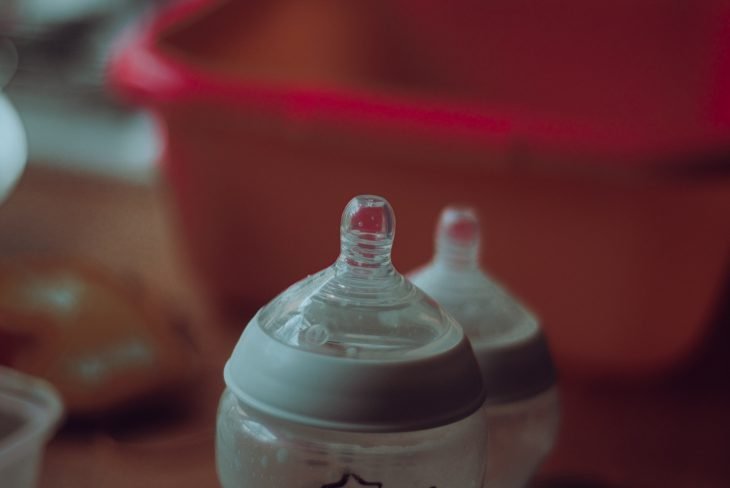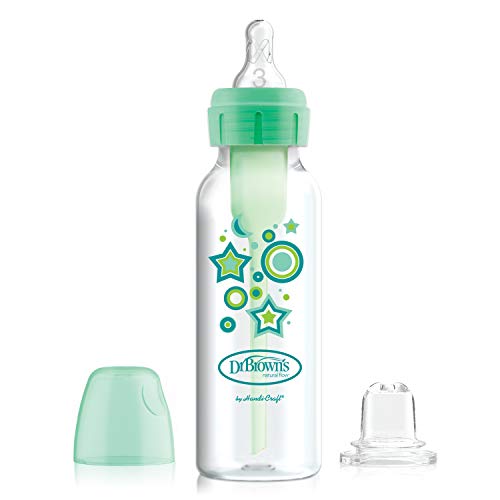If you love Dr. Brown’s vent bottles, you aren’t alone. But when to stop using Dr. Brown vent bottles? Since the many pieces that come with these bottles can prove a headache, some parents find themselves wondering when they’re able to do without them. In this post, we’ll answer exactly that as well as a few other frequently asked questions involving Dr. Brown’s popular anti-colic venting system.
How Long Do You Need to Use Anti-Colic Bottles For?
Anti-colic bottles can be used for as long as you need them; as long as you can put up with all of the parts and pieces, that is!
Many parents love the Dr. Brown bottle venting system but loathe assembly. Thankfully, according to Dr. Brown’s website, you can stop using his anti-colic bottle around the age of 4 months or whenever your baby’s colic symptoms cease.
Still feeling unsure? Try using the bottle without the vents for a few feeding sessions and see how it goes. If your baby seems comfortable and isn’t showing signs of discomfort, excessive burping, or excessive gas, then he or she is likely to be ready to ditch the venting system.
Other signs of readiness include:
- Starting Solid Foods
- Ability to Sit Up Alone
- Reduction of Colic Symptoms
- Calm and Happy Feedings (Instead of Baby Fussy During Feeding Bottle)
How Does Dr. Brown Vent System Work?
Dr. Brown’s vent system works by expelling the air that often gets trapped in the nipple of most bottles. While other brands may claim to do the same, most parents find that Dr. Brown’s venting system works best for colic in babies.
The inserts, usually green or blue, work to push air out of the nipple of the baby bottle so that this excess air doesn’t make its way into your baby’s stomach to cause your baby issues. Issues related to excess air in bottles include gassiness, fussiness, and cramps. These bottles can be used with the bottle warmer which can also hold bottles upright.

What Is the Green Insert in Dr Brown Bottles?
The green insert in Dr. Brown’s bottles is the venting system for the “Options Plus” bottle. These bottles are the newer version of the original “Options” bottle, which has blue inserts.
Note: There is a version of Dr. Brown’s bottles that are called the “Original” bottles. These bottles cannot be used without the venting inserts; otherwise, they’ll leak terribly. The Options bottles, on the other hand, can be used with or without the venting systems, making them the more feasible option for those wishing to continue using the bottle without the inserts after their baby becomes older.
Why Do My Dr Brown Bottles Leak Without Vent?
There are usually only a handful of reasons why your Dr. Brown bottles leak without the vent.
The first reason is that you’ve purchased the Original bottle which has to have the vent to operate correctly. By removing the vent in the original bottle, the bottle will leak extensively.
If you know you’ve purchased the Options or Options Plus bottles and are experiencing the same leakage, the problem is likely with how you are assembling the bottle. Proper assembly is key when piecing together your Option or Option Plus bottles. Follow the directions that came with your bottles carefully to ensure the bottle doesn’t leak.
How Long Can You Use Dr Brown Bottles?
As previously mentioned, you can use Dr. Brown bottles for as long as you need to. There’s one caveat though, and that’s bottle quality. If you notice wear and tear on the bottle, such as discoloration, leakage, and the like, it may just be time to replace the bottle.
In terms of how long you can use the venting system, the choice is completely yours, however, Dr. Brown suggests that you may be able to stop using the venting system as soon as 4 months.
How Often Should You Sterilize Dr Brown Bottles?
brown’s baby bottles are different from traditional baby bottles in that they use an internal vent system. If your baby was born premature, has a weakened immune system, is under three months, or is otherwise health impaired, you may wish to sterilize your Dr. Brown bottles at least once daily.
Related Read: Should you wear a bra to bed when breastfeeding?
How Do You Use Dr Brown Bottles With Vents?
To use Dr. Brown’s bottles with vents, do the following:
- Fill your bottle with the amount of milk you wish for your baby to consume.
- Put the nipple into the nipple collar.
- If you typically warm your baby’s milk, do that now.
- Put the reservoir into the insert.
- Put the reservoir into the bottle.
- Tighten the nipple collar over the bottle.
How Do You Clean Dr Brown Bottle Vents?
According to the Dr. Brown website, you’ll want to clean all parts belonging to the bottle by gently swirling them in warm water and soap, before rinsing them and allowing them to sit to air dry. The website suggests that you do this before using the bottle for the first time, and also suggests that you boil the nipple in hot water to rid it of germs and bacteria for about 5 minutes prior to use.
Sterilize the bottles when needed for babies under three months of age, particularly when you are traveling or when the bottle has made contact with the floor or a contaminated surface.
FAQ
Dr. Brown bottles usually stay sterile for about 24 hours, however, how long bottles stay sterile may vary depending on how you store them. Wondering when to stop sterilizing baby bottles? This usually occurs at about 3-4 months, which is around the age you can stop using Dr. Brown’s vent inserts if you choose to do so.
Dr. Brown’s Bottles Can Be Used Until You Decide to Quit!
To close, Dr. Brown’s bottles can be used until you wish to stop using them, but the vent systems within the bottle may not be needed for older babies that no longer deal with colic. If you aren’t sure whether or not your baby is ready to use the bottles without the vent, remove the vent for a few days to see how it goes. If your baby still shows signs of discomfort related to gas or digestive issues, you may wish to continue using the bottle until your baby no longer is displaying these signs.
Lynn
Lynn is a freelance writer, a wife, and a mother of two beautiful kids. Lynn started Infant Empire with the aim of making parenting easier for fellow mums and dads. She believes the parenting tips provided here will be of great help to all parents.Recommended Reading
5 Best Sterilizers for Comotomo Bottles (How To Clean & Sterilize) 2022
In this guide, we look at how to sterilize comotomo bottles using a sterilizer and also review the best sterilizer for comotomo bottles
7 Best Bottle Warmer For Comotomo Bottles Reviewed
If you are wondering which warmer is best for this bottles, below is a comprehensive guide of the best bottle warmer for Comotomo bottles.
Is A Bottle Warmer Necessary?
Is a bottle warmer necessary? Yes. You definitely need one for several reasons such as it is convenient, heats consistently and at right temperature...
How Many Scoops of Formula For 3 oz?
While most formulas give guidance for serving two and four ounces of formula, you may be wondering how many scoops of formula for 3 oz.
Orange Juice For Baby Constipation
We’ve set out to answer this question and more in today’s post about whether or not orange juice should be used to treat baby constipation.
Why Can’t You Add Warm Breast Milk to Cold?
Is there a reason why you can't add warm and cold breast milk? What are ways around it? We will answer all of that and more.



Leave a Reply